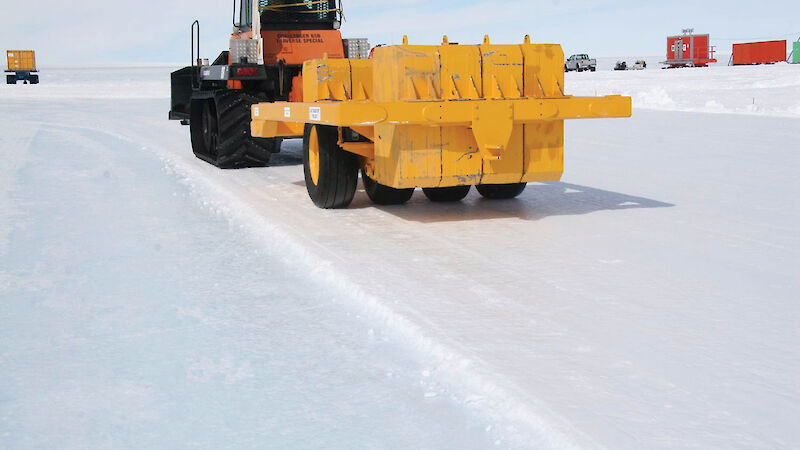Construction of Australia’s glacial blue ice runway in Antarctica is a testament to human innovation and endurance.
The 4000m Wilkins runway, funded by a $46.3 million grant from the Australian Government, has employed a range of exacting construction techniques and specifications to ensure its ability to support flights of a jet aircraft between Hobart and Antarctica in 2007–08.
Airlink Project Manager, Charlton Clark, said the runway site needed to be flat, at an altitude that was not too warm or too cold, and in an area of low snow accumulation.
“The site we selected is about 70km inland from Casey station,” Mr Clark said.
“It has low snow accumulation over winter, which minimises the amount of work we need to do at the outset of each season to remove snow from the infrastructure and the runway. It has a slope of less than two percent, so it is as close to flat as we can get. And it is at an altitude of 700m above sea level, which provides the best temperature conditions for runway construction.
The runway is situated on a blue ice glacier which, on its own, would be slippery and difficult to maintain, due to melting of the dark blue surface in the sunlight. To overcome this the construction team are capping the ice with a snow pavement, using techniques adapted from the United States Antarctic Program.
“As well as reflecting sunlight, the snow pavement increases the co-efficient of friction of the runway,” Mr Clark said.
“For example, blue ice is like an ice-skating rink, with a co-efficient of friction of 0.1. The snow pavement increases it to 0.3, which is equivalent to a concrete runway on a wet day at Melbourne airport.”
The pavement is made from fresh snow, which is spread across the graded blue ice surface and compressed with a roller to approx 100mm, so it is like concrete.
“We start compressing with a light weight and low tyre pressure, then add more and more weight up to 57 tonnes and increase the tyre pressure. This is like going from a sandshoe to a stiletto. Once we have achieved 100 percent coverage with the roller we let the snow crystal structure bond for 24 hours,” Mr Clark said.
The integrity of the pavement is then tested with a proof roller, which mimics the pressure of a C130 Hercules aircraft.
The pavement can only be built in temperatures of between −2°C and 3°C, which generally coincides with fine weather in Antarctica. Unfortunately, these conditions are unlikely to occur for a whole day, let alone over sequential days, and the construction team spend many hours in blizzard conditions and de-icing equipment.
Despite these obstacles the work is progressing on time, thanks in part to the delivery of $3 million of specialist equipment last season. Test flights are expected over the 2006–07 summer season, given the right weather conditions.
Runway facts
Length 4000 metres
Width 100 metres
Approx 70km from Casey station
Western threshold 700m above sea level
Eastern threshold 760m above sea level
Overall longitudinal slope 1.72%
Cross slope 0.220 to 0.984%
Glacial movement 12m/year to south west
Blue ice thickness approx 700m
Wilkins annual mean temperature −14°C

